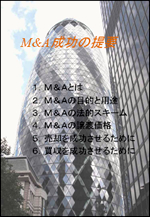Font Size
- S
- M
- L
M&A(Mergers and Acquisitions)
New Japan Business Consulting for M&A support Mergers and Acquisitions (M&A)
What is M&A?
M&A is an abbreviated name for Mergers and Acquisitions, which refers to mergers and acquisitions of companies. Generally, it involves the acquisition of shares in a target company to make it a consolidated entity or a subsidiary, often by absorbing or merging it with itself or its subsidiaries through a full acquisition. The purpose of M&A in business development is often to expand the company’s own performance through collaboration, with the thought process of a business alliance with investment, but M&A is also used to refer to the restructuring of a corporate group by bringing the acquired company into the group.
In the past, acquisitions in Japan were considered to be a form of business restructuring.
In the past, the terms ‘acquisition’ and ‘merger’ were often associated with a rather bleak image, perhaps because corporate acquisitions in Japan were often cases of rescue mergers of poorly performing companies, but in recent years the number of M&As has increased due to issues such as the lack of successors for small and medium-sized companies and the future of management with an eye on the future. In addition, the speed of change in the business environment has increased, and there is an increasing number of cases of acquisitions of existing companies because starting up a new business from scratch would delay its commercialisation. If you are only exposed to news reports on mergers and takeover bids, you are likely to imagine a fierce struggle for market supremacy. However, it is also worth remembering that the vast majority of M&A in Japan are friendly and targeted at small and medium-sized enterprises.
Current M&A problems
In the current situation, many deals that would otherwise have been concluded successfully are unsuccessful due to problems with the appropriateness of the transfer price when transferring a company or business during an M&A transaction. The transfer price of a company or business is assessed from the perspective of ‘how much the business is worth’. The value of the business here is not the figure shown in the net assets section of the balance sheet (B/S), but is basically calculated by replacing the profitability of the company or business to be transferred with its present value. However, as there are currently few experts who can convert the profitability of a business into present value in M&A, transfer negotiations frequently go wrong or run into impasse and become protracted. This is due to the fact that there is a discrepancy between the figures calculated by specialists who are familiar with finance theory and those who only use accounting to assess the transfer price. This is an ironclad rule.
M&A document ‘Compendium of successful mergers and acquisitions’







